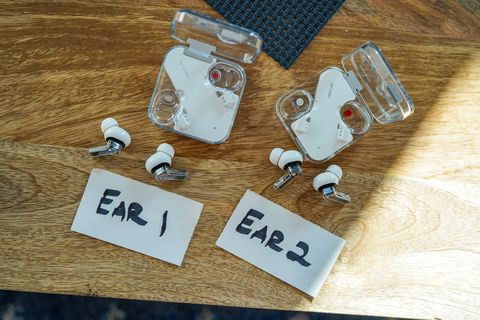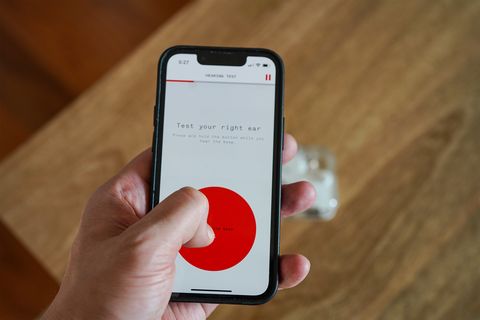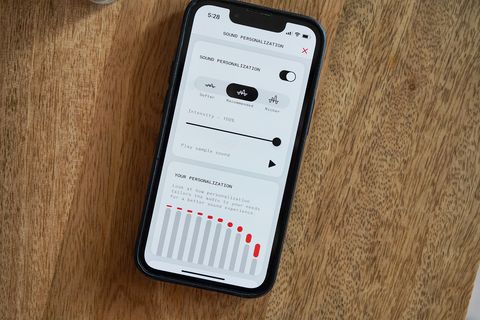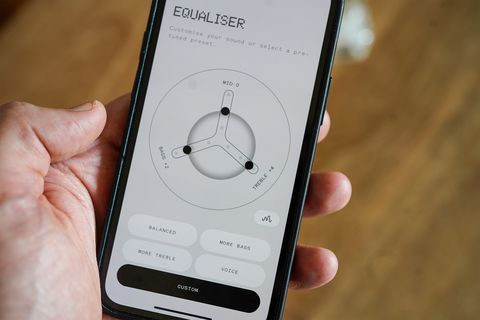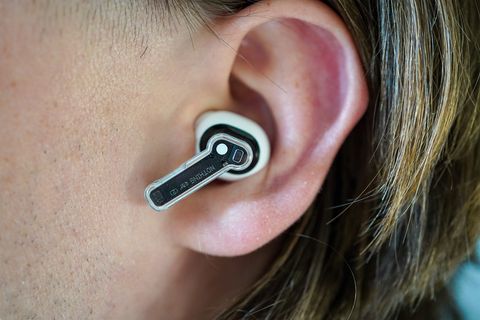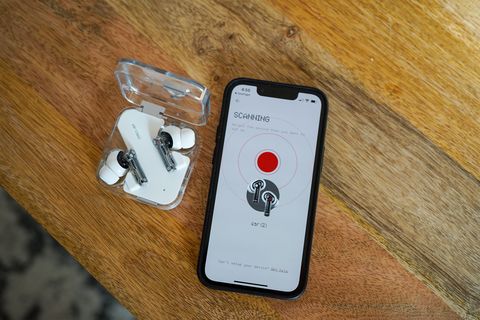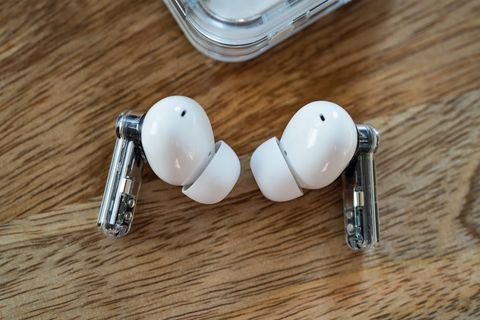The Nothing Ear (2) are the brand's new, so-called "premium" noise-canceling wireless earbuds. Consider them the next-gen version of the 2021-released Ear (1), because, well, they look nearly identical; each earbud has a semi-transparent design and is shaped more or less like one of Apple's AirPods Pro. That said, Nothing has improved basically everything with the Ear (2). They promise better sound, stronger noise-cancellation, longer battery life, improved durability and even welcome new features like multipoint Bluetooth connectivity and on-stem press controls.
-
 Nothing Ear (2) Read More
Nothing Ear (2) Read More
As for price, the Ear (2) cost $149 — which is technically the same as the Ear (1) have cost for the last six (ish) months, but not as cheap as they were when they first launched. (If you remember, Nothing actually raised the price of the Ear (1) — from $99 to $149 — when it introduced the Ear (stick), a more budget-friendly pair of wireless earbuds, this past fall.)
What's Good About the Nothing Ear (2) Earbuds?
They have a more refined, customizable sound.
The Nothing Ear (2) earbuds pack pretty much the same 11.6mm drivers that were in the Ear (1). However, according to Nothing, they have "a new dual-chamber design [that] enhances the overall sound quality with smoother airflow."
What makes a bigger difference is that Ear (2) allows you to create a custom sound profile for yourself. The companion app walks you through a roughly five-minute long hearing test — you have to press a button when you can hear various beeping noises in each ear — and then when switched on, all the music you hear is better customized for your ears.
I'm not going to say that the Ear (2) sound night-and-day better than the Ear (1), but I found that the vocals in Halsey's "So Good" and Tom Odell's "Another Love" sounded tighter and more vibrant. The bass still sounded a bit grainy at times when I played music at higher volumes — but I guess that's to be expected with wireless earbuds at this "more accessible" price point.
The Ear (2) support high-resolution streaming...for some.
One of the "big" things that Nothing touts with the Ear (2) is that they support LHDC 5.0 codec technology, which allows them to stream hi-res audio at up to 24-bit/192kHz — which is pretty much unheard for wireless earbuds, let along wireless earbuds that cost just $150. There is a big catch with this, however — and that's that most people won't be able to listen to it.
In order to take advantage of this lossless streaming on the Ear (2), you also need a smartphone that also supports LHDC 5.0. And right now, there are only a few Android smartphones that support it, such as flagship OPPO and OnePlus phones, as well as Nothing's Phone (1), which is only available in the U.S. in a beta testing program. Nothing says that more Android smartphones will roll out LHDC 5.0 support next month.
I wasn't able to test this new high-resolution streaming on the Ear (2), as I have an iPhone, but I have serious doubts that it could make that much difference on these wireless earbuds which on their own sound good but not great.
They have other "quality of life" upgrades
Nothing has given the Ear (2) a couple minor upgrades that, when added together, actually make a pretty big difference.
• First, they support Bluetooth multipoint. If you're somebody who wears wireless earbuds while working, you can connect the Ear (2) to two devices at the same time, like your computer and your smartphone; this allows you to listen to music on your computer and then quickly answer a call from your phone without missing a beat. This is a convenient feature that the Ear (1) lacked, but it's actually pretty common for most higher-end wireless earbuds these days.
• Second, Nothing has integrated the Ear (2) with on-stem press controls — rather than tap controls on the Ear (1) — that are very similar to the new AirPods Pro. This makes it a lot easier to do things like play/pause, skipping tracks, adjusting volume, switching between the several different noise-canceling modes. (Note: unlike the new AirPods Pro, you can't swipe up and down to adjust volume; instead, you need to customize a "press and hold" gesture via the app, so it's not quite as easy. )
• Third, the Ear (2) have a slightly more rugged design than the Ear (1). They have been an IP54 water-resistance rating, instead of the IPX4 rating of the Ear (1), meaning they have the same resistance against water — they are splash-resistant and, at the very least, fine to workout with or take running — but are slightly more resistance to solids like dust and grim.
• Fourth, the Ear (2) offer slightly better battery life than the Ear (1). With the case and with ANC turned off, the Ear (2) can get about 36 hours of juice — a slight upgrade over the 34 hours of the Ear (1). I haven't had a chance to do a deep dive on the battery life of the individual earbuds, but they should get around 6 hours of juice (or 4.5 hours with ANC turned on) which is pretty similar to the Ear (1).
What's Not Ideal About the Nothing Ear (2)?
Don't expect the active noise cancellation to blow you away.
The original Ear (1) had active noise cancellation, but it really wasn't anything to write home about. It did an average job at blocking out some low-end frequencies, but when compared against more premium wireless earbuds, they really didn't come close. Fast forward to the Ear (2), and while Nothing claims to have improved it — saying it's "Nothing's best noise cancellation technology yet, achieving up to 40 dB of noise reduction" — it's still not that impressive, especially when compared to the AirPods Pro 2, Bose QC Earbuds II and Sony WF-1000XM4s of the world.
One thing Nothing did improve with the noise-cancellation is that you now have more options. You can switch between different levels of noise-cancellation and even create a "personalized" noise-canceling setting that's better tuned for your ear's shape. There's also an "adaptive" noise-cancellation setting that automatically adjusts the Ear (2)'s ANC level depending on the noise in your environment. While cool in theory, the Ear (2)'s ANC isn't really that powerful enough to begin with for this to make much of a difference.
They aren't as cheap as they once were.
The main strike against the Ear (2) is price. They cost $149, which isn't crazy expensive by any means, but it's $50 more expensive than the Ear (1) were when they originally launched. It's well known that Nothing retroactively bumped the price of the Ear (1) after almost a year to make room for its more entry-level Ear (stick), which are the new $99 option, and that all makes sense. However, the Ear (2) have a lot more competition in the $149 range.
The Verdict: Nothing Ear (2) Wireless Earbuds
Nothing didn't have to fix what wasn't broken. The Ear (2) wireless earbuds built upon the already solid foundation that was the Ear (1), but make them a little better in basically every way. The main thing with the Ear (2) is that they allow more customization and tweaking. You can use the companion app to adjust and fine-tune sound and noise-canceling settings — and that's a definite good thing for those who like to tinker with their wireless earbuds.
That said, the Ear (2) look almost identical to the Ear (1) — basically, all the improvements are on the inside. And now they are more expensive than they previously were. In today's wireless earbud market, which is vast and diverse, the Ear (2) are a good and a fairly budget-friendly option for people drawn to its distinct transparent design. But don't expect them to sound as good or have nearly the same level of ANC as the flagship options by Sony, Bose, Apple and a few others.





